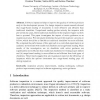Free Online Productivity Tools
i2Speak
i2Symbol
i2OCR
iTex2Img
iWeb2Print
iWeb2Shot
i2Type
iPdf2Split
iPdf2Merge
i2Bopomofo
i2Arabic
i2Style
i2Image
i2PDF
iLatex2Rtf
Sci2ools
PROFES
2005
Springer
2005
Springer
Investigating the Impact of Active Guidance on Design Inspection
Software inspection helps to improve the quality of software products early in the development process. For design inspection recent research showed that usage-based reading of documents is more effective and efficient than traditional checklists. Usage-based reading guides actively the inspector with pre-sorted use cases, while traditional checklists let the inspector figure out how best to proceed. This paper investigates the impact of active guidance on an inspection process: We introduced checklists that give the inspector a process to follow, which should be as flexible as traditional checklists but more efficient. We compared the performance of this approach in a controlled experiment in an academic environment with traditional checklist and usage-based reading. Main results of the investigation are (a) checklists with active guidance are significantly more efficient than traditional checklists for finding major defects and (b) usage-based reading is more effective and efficient ...
| Added | 28 Jun 2010 |
| Updated | 28 Jun 2010 |
| Type | Conference |
| Year | 2005 |
| Where | PROFES |
| Authors | Dietmar Winkler, Stefan Biffl, Bettina Thurnher |
Comments (0)

